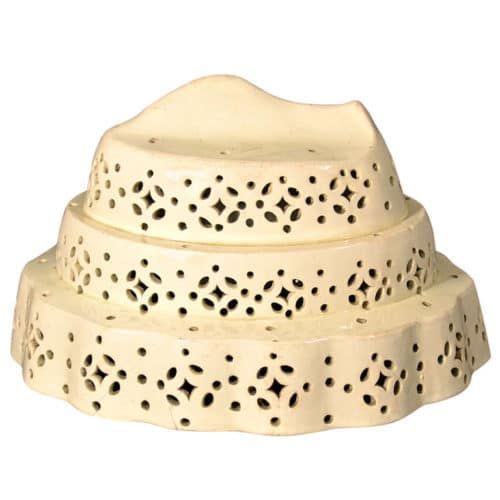At 1stdibs, we see beautiful and historically valuable examples of art and design each day — some of which intrigue us, baffle us or prove that we haven’t seen it all. In The Study’s Mystery Objects column, we look at an extraordinary offering from the 1stdibs inventory and reveal its intended (but not totally obvious) purpose.

A directional and avant-garde piece of headwear? A loosely handled ceramic stool? A vase aborted midway through construction? None of the above. This creamware vessel from the late 18th century would have been found not in a home’s living room or dressing closet, but instead in its kitchen.
But what exactly is it? A three-tier pierced culinary curd mold, says Paul Vandekar, an Englishman whose Maryknoll, New York gallery Vandekar carries the item. “In the 18th and 19th centuries, molds were used for baking desserts,” he explains. “This one is unusual because it has several levels and is open, so [the mold] would be made wet, and all the extra liquid could extrude out.”
If the phrase “wet mold” puts you off, consider the ancient Scottish recipe for which this mold was used: hatted kit. Made from milk with sugar and a dash of flavorings like cinnamon and nutmeg, hatted kit was essentially fresh, soft-curd cheese, not unlike crème fraîche. It was all the rage in the Scottish Highlands, and some culinary experts believe that the dish was originally made by milking a cow directly into it in — the better to put a “hat” on the kit, as they say. According to Vandekar, hatted kit could also be made from buttermilk and fresh milk in a milk-based pail, which would then be transferred to a mold like the one pictured here. “It tastes like fresh cheese served with fruit,” he says brightly.
Vandekar’s mold, which features the shape of Golden Carp fish in the center, also tells another story about the United Kingdom in 1785, the year he estimates the item was manufactured in Leeds. With its plain ivory color, the mold is a striking example of creamware, a type of pottery in use at the time. “Basically, it was just a basic clay with a thin glaze over the surface, so it looked like porcelain, but it was incredibly fragile,” he says. Though it wasn’t particularly heavy, it did “have a density to it, but at the same time, that’s the beauty of it; it’s not heavy like porcelain.”
Creamware’s fineness and durability can be credited to Josiah Wedgewood, an English potter who founded his pottery works, Wedgewood, in the 1750s. According to the Wedgewood Museum, it was around this time that the pottery company transformed “this earthenware body into a highly refined ceramic material,” which was then sold cheap and cast in a brilliant glaze similar to that of majolica. Among the most versatile ceramic materials out there, creamware, the museum says, was used for “everything from elaborate and ornamental vases to humble utilitarian wares.” “English creamware went to India, Russia, Turkey, all over the world,” Vandekar adds.
A big helping of hatted kit might hold a certain kitschy appeal with modern-day foodies, but most customers probably don’t know how the mold should be used, Vandekar says. But that’s okay. He insists that it’s part of the charm. “It’s almost like a work of art when you see an actual image of it,” he says. “From the outside, it looks like a piece of modern art, and that’s what’s so great about it. It just has this wonderful sort of presence to it.” For more lovely examples of olden-day creamware, we recommend visiting Vandekar’s 1stdibs store, where a Wedgewood food warmer and set of undecorated plates are up for grabs.